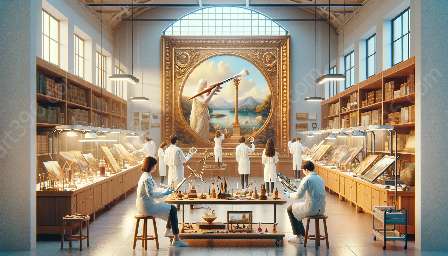Paints play a crucial role in artistic expression and the preservation of cultural heritage. Understanding the chemical composition of paints is essential for the conservation of paintings, as it directly influences their deterioration and methods of preservation. In this comprehensive guide, we will delve into the intricate world of paint chemistry and its implications for the conservation of art.
The Chemistry of Paints
The chemical composition of paints is multifaceted and varies based on the type of paint, its historical context, and the intended use. Generally, traditional paints consist of pigments, binders, solvents, and additives.
Pigments
Pigments are the finely ground particles that give paint its color. They can be derived from natural sources, such as minerals, plants, or animals, or they can be synthetic compounds created through chemical processes.
Binders
Binders, also known as resins, are the components that hold the pigment particles together and adhere them to the painting surface. Common binders include natural substances like linseed oil, and modern synthetic resins like acrylics.
Solvents
Solvents are used to dissolve or disperse the pigments and binders to achieve the desired paint consistency. They evaporate during the drying process, leaving behind the solid paint film.
Additives
Additives are incorporated into paint formulations to modify specific properties, such as drying time, texture, and durability. These can include stabilizers, driers, and anti-fungal agents.
Conservation Implications
The chemical composition of paints directly impacts their stability and susceptibility to deterioration over time. Factors such as light exposure, humidity, and pollutants can lead to chemical reactions and physical changes in the paint layer.
Deterioration Mechanisms
Understanding the specific degradation pathways of paint materials is crucial for developing effective conservation strategies. Common deterioration mechanisms include pigment fading, binder embrittlement, and the formation of cracks and delamination.
Preservation Techniques
Art conservation professionals employ a variety of techniques to mitigate the deterioration of painted surfaces. These can include controlled environmental conditions, surface cleaning, consolidation of flaking paint, and the application of protective coatings.
Intersecting with Art Conservation
The field of paint conservation intersects with broader art conservation practices, as paintings are complex cultural objects with multifaceted preservation needs. Technical expertise in paint chemistry and material science is essential for successful art conservation and restoration.
Collaborative Approach
Conserving paintings requires a collaborative approach that integrates scientific analysis, historical research, and artistic intent. Conservation professionals work closely with art historians, curators, and conservators to develop comprehensive conservation plans.
Educational Outreach
Sharing knowledge about the chemical composition of paints and its conservation implications is vital for raising awareness about the importance of preserving our cultural heritage. Educational outreach efforts aim to engage the public in the value of art conservation.
Conclusion
Understanding the chemical composition of paints and its conservation implications is fundamental for the long-term preservation of paintings and cultural artifacts. By integrating scientific knowledge with artistic appreciation, we can ensure that future generations continue to experience the beauty and significance of our artistic heritage.

